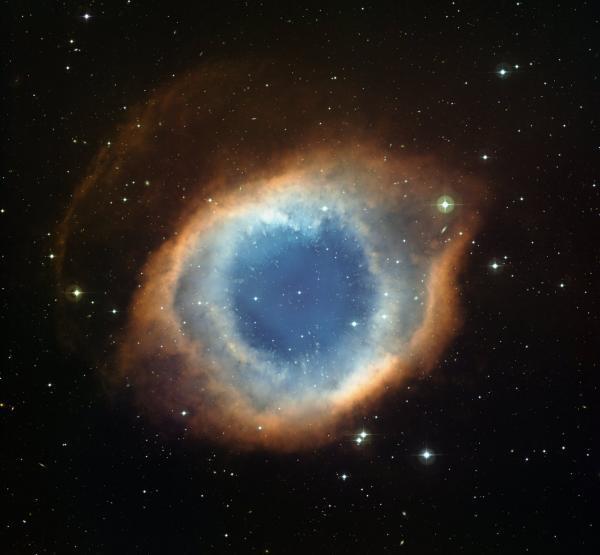The eye of the Helix Nebula
The large market camera of La Silla Observatory (ESO) has just captured a picture of Helix planetary nebula. On the background of the photo are distant galaxies, which often do not appear in other photographs of the nebula.
The Helix Nebula, NGC 7293, is located about 700 light years away from the constellation Aquarius. It is one of the closest and most brilliant examples of a planetary nebula. This strange object has nothing to do with the planet, but it is the brilliant phase of the end of a sun-like star before it becomes a white dwarf.
The outer shell is blown out of the star's surface, often in beautiful but rather complex styles. It glows under intense ultraviolet radiation from the central, but faint, central star. The main belt of the Helix nebula has a diameter of about 2 light years, only half the distance of the sun and its nearest neighbor star.
 The Helix Nebula image (NGC 7293) is made up of images from a wide-field telescope (WFI) - an astronomical camera mounted on a 2.2-meter telescope at La Silla observatory at Chile (Planck Society / ESO). Green and green light at the center of Helix comes from brilliant oxygen atoms under the action of intense ultraviolet radiation of hot gas and the central star Celsius is 120,000 degrees hot. Further outside the star through both the belt of the knot, the red of hydrogen and nitrogen becomes more prominent. Looking closely at the center of this object will see the knots, and there are many galaxies in the distance behind the fragile gas glow. The photo above was assembled from photographs taken under the red, green and green filters with a total time of 12 minutes, 9 minutes and 7 minutes respectively. (Photo: ESO)
The Helix Nebula image (NGC 7293) is made up of images from a wide-field telescope (WFI) - an astronomical camera mounted on a 2.2-meter telescope at La Silla observatory at Chile (Planck Society / ESO). Green and green light at the center of Helix comes from brilliant oxygen atoms under the action of intense ultraviolet radiation of hot gas and the central star Celsius is 120,000 degrees hot. Further outside the star through both the belt of the knot, the red of hydrogen and nitrogen becomes more prominent. Looking closely at the center of this object will see the knots, and there are many galaxies in the distance behind the fragile gas glow. The photo above was assembled from photographs taken under the red, green and green filters with a total time of 12 minutes, 9 minutes and 7 minutes respectively. (Photo: ESO)
Although the image of the Helix is brilliant, it is difficult to observe it with the naked eye because its light spreads thinly in a large sky, its history is quite vague. It first appeared in the list of new objects launched by German astronomer Karl Ludwig Harding in 1824. Helix names come from the shape of the corkscrew as observed in the photos. before. Although Helix looks pretty much like a donut, studies have shown that it consists of at least two separate plates with outer rings and tiny fibers.The brighter inner disk spreads about 100,000 km / h, and took up to 12,000 years to form.
Because Helix is quite close, it covers about a quarter of the moon full moon in the sky, it can be studied in more detail than any other planetary planet. It was also discovered that it had a rather complex structure that was unexpected. The inside of the belt is small round spots, called the 'comet knot' with a faint tail that extends from the central star. They look quite like liquid droplets flowing down from the glass. Although it looks fragile, each knot is equal to our own solar system. These bottlenecks are well studied with the extremely large telescope VLT (ESO) and the Hubble space telescope (NASA / ESA), but it is still not fully understood.
Looking closely at the central part of this object, we will discover not only the knots and many galaxies far behind the fragile glowing gas. Some galaxies seem to gather into separate galactic groups scattered throughout the image.)
- The magical beauty of the 'eyes of God'
- Performing fireworks in the Helix Nebula
- The nebula is like a giant crimson eye in the universe
- Beautiful photo: Physical dust and gas surrounding the Helix nebula
- 'God's eyes' in the universe
- Beautiful sight of a dying star
- See the most beautiful astronomical photos on display in London
- Huge blue eyes glow in the universe
- Discovered nebula like engagement ring
- Things you didn't know about the Nebula
- Helix: The world's most compact folding bike
- The rushing dance to the death of the mysterious nebula
 Van Allen's belt and evidence that the Apollo 11 mission to the Moon was myth
Van Allen's belt and evidence that the Apollo 11 mission to the Moon was myth The levels of civilization in the universe (Kardashev scale)
The levels of civilization in the universe (Kardashev scale) Today Mars, the sun and the Earth are aligned
Today Mars, the sun and the Earth are aligned The Amazon owner announced a secret plan to build a space base for thousands of people
The Amazon owner announced a secret plan to build a space base for thousands of people